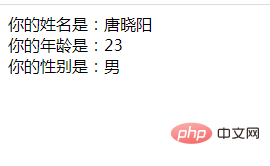What does the php code $sum=0 mean?
php code "$sum=0" means creating (declaring) a variable "$sum" and initializing it, assigning 0 to the variable. The declaration of a variable in PHP must be represented by the dollar sign "$" followed by the variable name, and the assignment operator "=" is used to assign a value to the variable. PHP variables are identifiers prefixed with the dollar sign "$". An identifier is a symbol that identifies different objects and must comply with some rules: it can only be composed of letters, numbers, underscore characters, and other ASCII characters from 127 to 255. , must start with a letter or underscore, etc.

The operating environment of this tutorial: windows7 system, PHP8 version, DELL G3 computer
php code "$sum=0" means Create (declare) a variable "$sum" and initialize it, assigning 0 to the variable.
Introduction to PHP variables
Variables in PHP are identifiers prefixed with the dollar sign ($). The identifier is A symbol that identifies different objects, such as the name of a variable, the name of a function, or the name of other user-defined objects. In PHP, the naming of identifiers must comply with the following regulations:
Identifiers can consist of one or more characters, but must start with a letter or an underscore. Additionally, identifiers may only consist of letters, numbers, underscore characters, and other ASCII characters from 127 to 255. Identifier names such as my_a, Ss, and _value are all legal, but variable names such as q^a and 4tt are illegal.
Identifiers are case-sensitive. Therefore, the variable $recipe is different from the variables $Recipe, $rEciPe or $recipE.
Identifiers can be of any length. This is beneficial because it allows the programmer to accurately describe the purpose of the identifier through its name.
#The identifier name cannot be the same as any PHP predefined keyword.
php variable declaration
The declaration of variables in PHP must be expressed with a dollar sign followed by the variable name, using the assignment operator (=) Assign a value to a variable. Example:
$sum=0;
In the process of creating a variable, it is a good habit to declare the variable first and then assign a value to the variable.
Since PHP is a weakly typed language, there is no need to explicitly declare variables when declaring variables. Variables can store any type of value. In PHP, variables are type checked at runtime and can be used with another A value of a different type replaces the variable's value.
The following declares a variable, replaces the value of the variable with another value of a different type, and then declares a variable without assignment. The specific code is as follows:
$what = “Yound Tang”; $what = 25; $name;
In PHP, There are two ways to assign values to variables, namely value assignment and reference assignment. Value assignment is to directly copy a value to a variable through an assignment expression, which will overwrite the original value of the variable. If there is no assignment when declaring the variable, its behavior will be the same as NULL. Assigning a value when declaring a variable is a commonly used variable assignment method. The usage example is as follows:
<?php
header("Content-type:text/html;charset=utf-8");
$name = "唐晓阳";
$age = "23";
$sex = "男";
echo "你的姓名是:".$name."<br/>";
echo "你的年龄是:".$age."<br/>";
echo "你的性别是:".$sex."<br/>";
?>Execute this code and the execution result is as follows:

In PHP, the declared variable can be assigned a value directly or not. When a variable needs to be used to store a value, the variable can be assigned a reference. The reference assignment means that the created variable has the same content as that referenced by another variable. Therefore, if multiple variables refer to the same content, modifying any one of them will be reflected in the remaining variables. Reference assignment can be completed by adding an & symbol after the equal sign. An example form of reference assignment is as follows:
$value1="Hello World"; value2=&value1; $value2="GoodBye"; echo $value1.”<br/>”; echo $value2.”<br/>”;
In the above code, a variable value1 is created and assigned the value "Hello World". In the following statement, the variable $value2 uses reference assignment, that is, value1 The value of is assigned to value2. At this time, these two variables are a life community. When one changes, the other one will display the result. The execution result of this code is as follows:
GoodBye GoodBye
Recommended learning : "PHP Video Tutorial"
The above is the detailed content of What does the php code $sum=0 mean?. For more information, please follow other related articles on the PHP Chinese website!

Hot AI Tools

Undresser.AI Undress
AI-powered app for creating realistic nude photos

AI Clothes Remover
Online AI tool for removing clothes from photos.

Undress AI Tool
Undress images for free

Clothoff.io
AI clothes remover

Video Face Swap
Swap faces in any video effortlessly with our completely free AI face swap tool!

Hot Article

Hot Tools

Notepad++7.3.1
Easy-to-use and free code editor

SublimeText3 Chinese version
Chinese version, very easy to use

Zend Studio 13.0.1
Powerful PHP integrated development environment

Dreamweaver CS6
Visual web development tools

SublimeText3 Mac version
God-level code editing software (SublimeText3)

Hot Topics
 PHP 8.4 Installation and Upgrade guide for Ubuntu and Debian
Dec 24, 2024 pm 04:42 PM
PHP 8.4 Installation and Upgrade guide for Ubuntu and Debian
Dec 24, 2024 pm 04:42 PM
PHP 8.4 brings several new features, security improvements, and performance improvements with healthy amounts of feature deprecations and removals. This guide explains how to install PHP 8.4 or upgrade to PHP 8.4 on Ubuntu, Debian, or their derivati
 7 PHP Functions I Regret I Didn't Know Before
Nov 13, 2024 am 09:42 AM
7 PHP Functions I Regret I Didn't Know Before
Nov 13, 2024 am 09:42 AM
If you are an experienced PHP developer, you might have the feeling that you’ve been there and done that already.You have developed a significant number of applications, debugged millions of lines of code, and tweaked a bunch of scripts to achieve op
 How To Set Up Visual Studio Code (VS Code) for PHP Development
Dec 20, 2024 am 11:31 AM
How To Set Up Visual Studio Code (VS Code) for PHP Development
Dec 20, 2024 am 11:31 AM
Visual Studio Code, also known as VS Code, is a free source code editor — or integrated development environment (IDE) — available for all major operating systems. With a large collection of extensions for many programming languages, VS Code can be c
 Explain JSON Web Tokens (JWT) and their use case in PHP APIs.
Apr 05, 2025 am 12:04 AM
Explain JSON Web Tokens (JWT) and their use case in PHP APIs.
Apr 05, 2025 am 12:04 AM
JWT is an open standard based on JSON, used to securely transmit information between parties, mainly for identity authentication and information exchange. 1. JWT consists of three parts: Header, Payload and Signature. 2. The working principle of JWT includes three steps: generating JWT, verifying JWT and parsing Payload. 3. When using JWT for authentication in PHP, JWT can be generated and verified, and user role and permission information can be included in advanced usage. 4. Common errors include signature verification failure, token expiration, and payload oversized. Debugging skills include using debugging tools and logging. 5. Performance optimization and best practices include using appropriate signature algorithms, setting validity periods reasonably,
 PHP Program to Count Vowels in a String
Feb 07, 2025 pm 12:12 PM
PHP Program to Count Vowels in a String
Feb 07, 2025 pm 12:12 PM
A string is a sequence of characters, including letters, numbers, and symbols. This tutorial will learn how to calculate the number of vowels in a given string in PHP using different methods. The vowels in English are a, e, i, o, u, and they can be uppercase or lowercase. What is a vowel? Vowels are alphabetic characters that represent a specific pronunciation. There are five vowels in English, including uppercase and lowercase: a, e, i, o, u Example 1 Input: String = "Tutorialspoint" Output: 6 explain The vowels in the string "Tutorialspoint" are u, o, i, a, o, i. There are 6 yuan in total
 How do you parse and process HTML/XML in PHP?
Feb 07, 2025 am 11:57 AM
How do you parse and process HTML/XML in PHP?
Feb 07, 2025 am 11:57 AM
This tutorial demonstrates how to efficiently process XML documents using PHP. XML (eXtensible Markup Language) is a versatile text-based markup language designed for both human readability and machine parsing. It's commonly used for data storage an
 Explain late static binding in PHP (static::).
Apr 03, 2025 am 12:04 AM
Explain late static binding in PHP (static::).
Apr 03, 2025 am 12:04 AM
Static binding (static::) implements late static binding (LSB) in PHP, allowing calling classes to be referenced in static contexts rather than defining classes. 1) The parsing process is performed at runtime, 2) Look up the call class in the inheritance relationship, 3) It may bring performance overhead.
 What are PHP magic methods (__construct, __destruct, __call, __get, __set, etc.) and provide use cases?
Apr 03, 2025 am 12:03 AM
What are PHP magic methods (__construct, __destruct, __call, __get, __set, etc.) and provide use cases?
Apr 03, 2025 am 12:03 AM
What are the magic methods of PHP? PHP's magic methods include: 1.\_\_construct, used to initialize objects; 2.\_\_destruct, used to clean up resources; 3.\_\_call, handle non-existent method calls; 4.\_\_get, implement dynamic attribute access; 5.\_\_set, implement dynamic attribute settings. These methods are automatically called in certain situations, improving code flexibility and efficiency.






